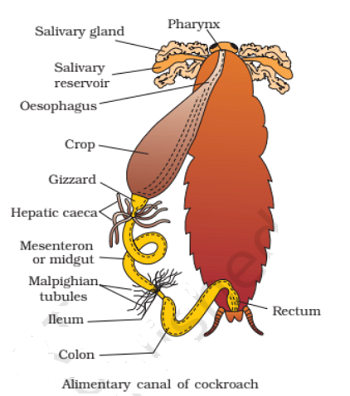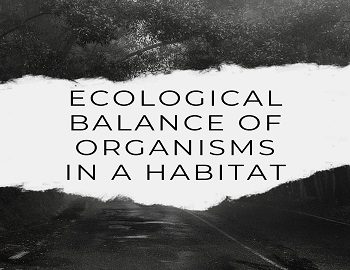Table of Contents
Digestive System of Cockroach:
The digestive system of cockroach consists of Preoral Cavity, Alimentary Canal and Digestive Glands.

Preoral Cavity:
The preoral cavity is formed in front of the mouth opening and is formed by various mouthparts. The floor of the preoral cavity is formed by labium or lower lip, roof by labrum and epipharynx or upper lip and sides by mandibles and first pair of maxillae. The tongue-like hypopharynx lies in the space of the preoral cavity. The common salivary duct opens at the base of the hypopharynx, just in front of the mouth. The salivary secretion is poured into the preoral cavity.
Alimentary Canal:
The alimentary canal is 6-7 cm in length and is present in the body cavity. It is divided into three regions: foregut, midgut and hindgut.
Foregut- Foregut develops from embryonic stomodaeum and is differentiated into the buccal cavity, pharynx, oesophagus, crop and gizzard. The mouth opens into a small buccal chamber which immediately opens into a tubular pharynx. The pharynx extends vertically upwards and bends backwards to open into the oesophagus. Several dilatory muscles extend from the wall of the buccal cavity and pharynx and are inserted into the tentorium and sclerites of the head capsule. These muscles help in engulfing the food. The oesophagus passes through the neck and opens into a sac-like structure called a crop. The oesophagus is normally kept closed by internal folds except during ingestion. A crop is a large pear-shaped sac that stores food. The posterior 1/3 part of the crop has both digestive and churning functions. Enzymes come from the mid-gut. From the crop, the food enters a conical and muscular part called Gizzard or proventriculus. Its internal structure has six large chitinous teeth in the anterior part, six thin plates and then six pads having bristles studded cushions in the posterior part. Fine bristles also occur in the grooves of the gizzard. Gizzard has, therefore, efficient grinding and straining apparatus. Gizzard marks the end of the foregut. Its posterior end projects in the form of a narrow tube into the mid-gut. It is called a stomodaeal valve. The valve checks regurgitation. The foregut is lined with cuticle and ectodermal epithelium. It protects the alimentary canal from rough food particles.
Midgut or Mesenteron- The midgut is a short and narrow tube behind the gizzard and is glandular in nature. At the junctional region of the gizzard are eight fingers like tubular blind processes called the hepatic caeca or enteric caeca. The internal lining of the midgut is thrown out into small but several folds forming villi and covered by a very thin layer of the transparent peritrophic membrane. The peritrophic membrane is secreted by the anterior end of the cardia and it is permeable for enzymes and for the end products of digestion. It also protects the wall of the midgut. The process of digestion is completed in this region of the alimentary canal and the digested food is also absorbed in it.
Hindgut or Proctodaeum- It is slightly broader than the mid-gut and is lined internally by a cuticle. The hindgut is differentiated into three parts- ileum, colon and rectum. The ileum is short and narrow. It internally bears short spines. At its junction with the midgut is present a ring of up to 150 yellow thread-like blind malpighian tubules. They are excretory in nature. Their product is poured into the rectum. The colon is the longest middle part of the hindgut. It is relatively thicker and coiled. Its wall is also produced into folds. The rectum is the smallest posterior part. It opens to the exterior by the anus. Its wall is raised into six longitudinal folds, called rectal papillae. These absorb water from the faeces.
Digestive Glands:
The digestive glands of the cockroach consist of the salivary glands, the glandular cells and hepatic caeca. A pair of salivary glands are found on either side of the crop in the thorax. Each gland has two glandular portions and a bag-like diverticulum or receptacle or reservoir in which saliva is stored. The glandular cells of the midgut and hepatic or gastric caeca produce digestive juices.
Physiology of Digestion:
The cockroach is an omnivorous animal, the food is ingested by the sense of smell and is masticated with the teeth of mandibles. The food is then passed into the buccal cavity where it mixes with the saliva secreted by two pairs of a salivary gland. Saliva contains digested enzymes that digest the starch. Ultimately, the food enters into the crop where it is stored and gradually transferred into the gizzard. In the gizzard, the chitinous teeth further masticate the food. The fine particles of food are then entered into the midgut. The linning of midgut and hepatic caeca secretes various digestive enzymes like amylase, maltase, lactase, lipase, cellulase, peptidase and protease etc. Bacteria present in the midgut synthesize cellulose. All these enzymes digest (hydrolysed) and break the complex organic molecules of proteins, fat and starch into simpler forms. These simpler forms are mostly absorbed in the midgut. The lining cells of the hepatic caeca absorb the glucose only. The excess food is absorbed in the fat bodies. The undigested food then passes to the hindgut where undigested water and mineral salts are absorbed. The undigested food then passes to the hindgut where undigested water and mineral salts are absorbed. The undigested food is then egested out of the body through the rectal opening, anus.









Comments (No)